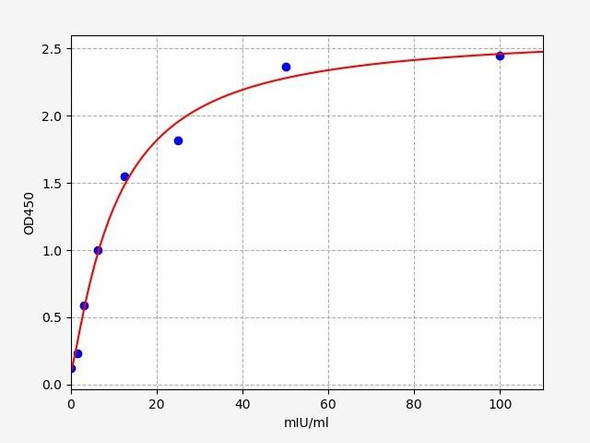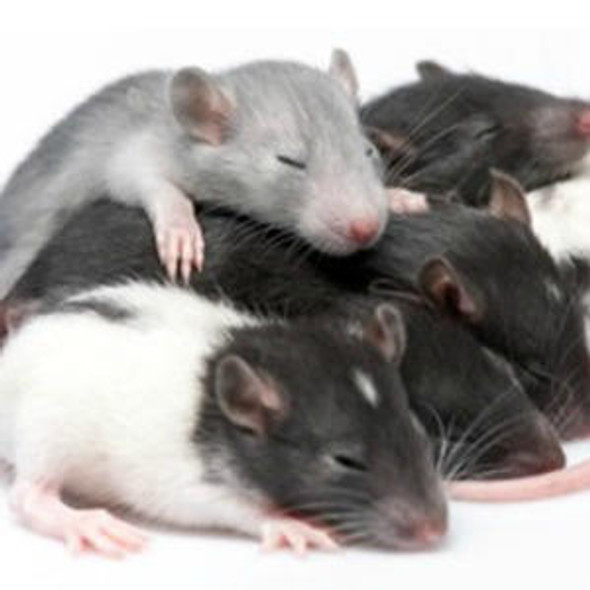Rat Dopamine Receptor D3 / DRD3 ELISA Kit
- SKU:
- RTFI00739
- Product Type:
- ELISA Kit
- Size:
- 96 Assays
- Uniprot:
- P19020
- Sensitivity:
- 0.188ng/ml
- Range:
- 0.313-20ng/ml
- ELISA Type:
- Sandwich ELISA, Double Antibody
- Synonyms:
- DRD3
- Reactivity:
- Rat
Description
| Product Name: | Rat DRD3 (Dopamine Receptor D3) ELISA Kit |
| Product Code: | RTFI00739 |
| Size: | 96 Assays |
| Target: | Rat DRD3 |
| Alias: | DRD3 |
| Reactivity: | Rat |
| Detection Method: | Sandwich ELISA, Double Antibody |
| Sensitivity: | 187.5pg/ml |
| Range: | 312.5-20000pg/ml |
| Storage: | 4°C for 6 months |
| Note: | For Research Use Only |
| Recovery: | Matrices listed below were spiked with certain level of Rat DRD3 and the recovery rates were calculated by comparing the measured value to the expected amount of Rat DRD3 in samples. | ||||||||||||||||
| |||||||||||||||||
| Linearity: | The linearity of the kit was assayed by testing samples spiked with appropriate concentration of Rat DRD3 and their serial dilutions. The results were demonstrated by the percentage of calculated concentration to the expected. | ||||||||||||||||
| |||||||||||||||||
| Intra-Assay: | CV <8% | ||||||||||||||||
| Inter-Assay: | CV <10% |
| Uniprot: | P19020 |
| UniProt Protein Function: | DRD3: Dopamine receptor whose activity is mediated by G proteins which inhibit adenylyl cyclase. Promotes cell proliferation. Genetic variation in DRD3 is associated with essential tremor hereditary type 1 (ETM1). ETM1 is the most common movement disorder. The main feature is postural tremor of the arms. Head, legs, trunk, voice, jaw, and facial muscles also may be involved. The condition can be aggravated by emotions, hunger, fatigue and temperature extremes, and may cause a functional disability or even incapacitation. Inheritance is autosomal dominant. Belongs to the G-protein coupled receptor 1 family. 2 isoforms of the human protein are produced by alternative splicing. |
| UniProt Protein Details: | Protein type:Membrane protein, multi-pass; Receptor, GPCR; GPCR, family 1; Membrane protein, integral Cellular Component: apical part of cell; cell projection; endocytic vesicle; integral to plasma membrane; membrane; plasma membrane Molecular Function:D1 dopamine receptor binding; dopamine binding; dopamine D1 receptor-like receptor activity; dopamine D2 receptor-like receptor activity; dopamine receptor activity; drug binding; protein binding; protein domain specific binding Biological Process: acid secretion; arachidonic acid secretion; behavioral response to cocaine; cellular calcium ion homeostasis; circadian regulation of gene expression; dopamine receptor signaling pathway; dopamine receptor, adenylate cyclase activating pathway; dopamine receptor, adenylate cyclase inhibiting pathway; G-protein coupled receptor internalization; G-protein coupled receptor protein signaling pathway; locomotory behavior; musculoskeletal movement, spinal reflex action; negative regulation of adenylate cyclase activity; negative regulation of blood pressure; negative regulation of dopamine receptor signaling pathway; negative regulation of oligodendrocyte differentiation; negative regulation of protein kinase B signaling cascade; negative regulation of protein secretion; negative regulation of sodium:hydrogen antiporter activity; negative regulation of transcription from RNA polymerase II promoter; positive regulation of cell proliferation; positive regulation of cytokinesis; positive regulation of dopamine receptor signaling pathway; positive regulation of mitosis; positive regulation of transcription from RNA polymerase II promoter; prepulse inhibition; regulation of cAMP metabolic process; regulation of circadian sleep/wake cycle, sleep; regulation of dopamine secretion; regulation of lipid metabolic process; regulation of locomotion; regulation of multicellular organism growth; renin-angiotensin regulation of blood volume; response to amphetamine; response to cocaine; response to drug; response to ethanol; response to morphine; synaptic transmission, dopaminergic; visual learning |
| NCBI Summary: | may be involved in facilitating the effects of antipsychotic drugs and drug treatments for Parkinson's disease [RGD, Feb 2006] |
| UniProt Code: | P19020 |
| NCBI GenInfo Identifier: | 118211 |
| NCBI Gene ID: | 29238 |
| NCBI Accession: | P19020.1 |
| UniProt Secondary Accession: | P19020,P70647, |
| UniProt Related Accession: | P19020 |
| Molecular Weight: | Predicted: 50 kDa |
| NCBI Full Name: | D(3) dopamine receptor |
| NCBI Synonym Full Names: | dopamine receptor D3 |
| NCBI Official Symbol: | Drd3 |
| NCBI Protein Information: | D(3) dopamine receptor |
| UniProt Protein Name: | D(3) dopamine receptor |
| UniProt Synonym Protein Names: | Dopamine D3 receptor |
| Protein Family: | D(3) dopamine receptor |
| UniProt Gene Name: | Drd3 |
| UniProt Entry Name: | DRD3_RAT |
| Step | Procedure |
| 1. | Set standard, test sample and control (zero) wells on the pre-coated plate respectively, and then, record their positions. It is recommended to measure each standard and sample in duplicate. Wash plate 2 times before adding standard, sample and control (zero) wells! |
| 2. | Aliquot 0.1ml standard solutions into the standard wells. |
| 3. | Add 0.1 ml of Sample / Standard dilution buffer into the control (zero) well. |
| 4. | Add 0.1 ml of properly diluted sample ( Human serum, plasma, tissue homogenates and other biological fluids.) into test sample wells. |
| 5. | Seal the plate with a cover and incubate at 37°C for 90 min. |
| 6. | Remove the cover and discard the plate content, clap the plate on the absorbent filter papers or other absorbent material. Do NOT let the wells completely dry at any time. Wash plate X2. |
| 7. | Add 0.1 ml of Biotin- detection antibody working solution into the above wells (standard, test sample & zero wells). Add the solution at the bottom of each well without touching the side wall. |
| 8. | Seal the plate with a cover and incubate at 37°C for 60 min. |
| 9. | Remove the cover, and wash plate 3 times with Wash buffer. Let wash buffer rest in wells for 1 min between each wash. |
| 10. | Add 0.1 ml of SABC working solution into each well, cover the plate and incubate at 37°C for 30 min. |
| 11. | Remove the cover and wash plate 5 times with Wash buffer, and each time let the wash buffer stay in the wells for 1-2 min. |
| 12. | Add 90 µL of TMB substrate into each well, cover the plate and incubate at 37°C in dark within 10-20 min. (Note: This incubation time is for reference use only, the optimal time should be determined by end user.) And the shades of blue can be seen in the first 3-4 wells (with most concentrated standard solutions), the other wells show no obvious color. |
| 13. | Add 50 µL of Stop solution into each well and mix thoroughly. The color changes into yellow immediately. |
| 14. | Read the O.D. absorbance at 450 nm in a microplate reader immediately after adding the stop solution. |
When carrying out an ELISA assay it is important to prepare your samples in order to achieve the best possible results. Below we have a list of procedures for the preparation of samples for different sample types.
| Sample Type | Protocol |
| Serum: | If using serum separator tubes, allow samples to clot for 30 minutes at room temperature. Centrifuge for 10 minutes at 1,000x g. Collect the serum fraction and assay promptly or aliquot and store the samples at -80°C. Avoid multiple freeze-thaw cycles. If serum separator tubes are not being used, allow samples to clotovernight at 2-8°C. Centrifuge for 10 minutes at 1,000x g. Removeserum and assay promptly or aliquot and store the samples at-80°C. Avoid multiple freeze-thaw cycles. |
| Plasma: | Collect plasma using EDTA or heparin as an anti-coagulant. Centrifuge samples at 4°C for 15 mins at 1000 — g within 30 mins of collection. Collect the plasma fraction and assay promptly or aliquot and store the samples at -80°C. Avoid multiple freeze-thaw cycles.Note: Over haemolysed samples are not suitable for use with this kit. |
| Urine & Cerebrospinal Fluid: | Collect the urine (mid-stream) in a sterile container, centrifuge for 20 mins at 2000-3000 rpm. Remove supernatant and assay immediately. If any precipitation is detected, repeat the centrifugation step. A similar protocol can be used for cerebrospinal fluid. |
| Cell Culture Supernatant: | Collect the cell culture media by pipette, followed by centrifugation at 4°C for 20 mins at 1500 rpm. Collect the clear supernatant and assay immediately. |
| Cell Lysates: | Solubilize cells in lysis buffer and allow to sit on ice for 30 minutes. Centrifuge tubes at 14,000 x g for 5 minutes to remove insoluble material. Aliquot the supernatant into a new tube and discard the remaining whole cell extract. Quantify total protein concentration using a total protein assay. Assay immediately or aliquot and store at ≤ -20°C. |
| Tissue Homogenates: | The preparation of tissue homogenates will vary depending upon tissue type. Rinse tissue with 1X PBS to remove excess blood & homogenizein 20ml of 1X PBS (including protease inhibitors) and store overnight at ≤ -20°C. Two freeze-thaw cycles are required to break the cell membranes. To further disrupt the cell membranes you can sonicate the samples. Centrifuge homogenates for 5 mins at 5000xg. Remove the supernatant and assay immediately or aliquot and store at -20°C or-80°C. |
| Tissue Lysates: | Rinse tissue with PBS, cut into 1-2 mm pieces, and homogenize with a tissue homogenizer in PBS. Add an equal volume of RIPA buffer containing protease inhibitors and lyse tissues at room temperature for 30 minutes with gentle agitation. Centrifuge to remove debris. Quantify total protein concentration using a total protein assay. Assay immediately or aliquot and store at ≤ -20 °C. |
| Breast Milk: | Collect milk samples and centrifuge at 10,000 x g for 60 min at 4°C. Aliquot the supernatant and assay. For long term use, store samples at -80°C. Minimize freeze/thaw cycles. |










